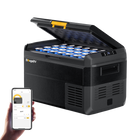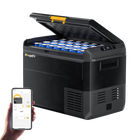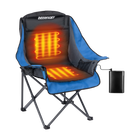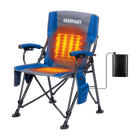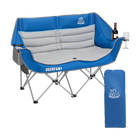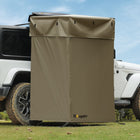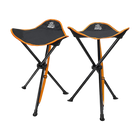- Features
- Tech Specs
- Reviews
- FAQ
Features


HIGHLIGHTS


N-TYPE Technology Solar Cell, 25% Highest Conversion Rate. BougeRV N-TYPE 300-watt solar panels are made of N-TYPE solar cells. Compared to P-TYPE solar cells, N-TYPE solar cells add an advanced Industrial Tunnel Oxide Passivated.


Bifacial Design Increases the solar output by 30%. Instead of having an opaque back, BougeRV bifacial solar panels feature a transparent backside, allowing it to absorb solar energy from both sides, such as direct sunlight, refracted sunlight, and diffuse sunlight. N-type solar cells have an 80% bifacial gain while P-TYPE have only a 70% bifacial gain.


More 5-Year Power Lifespan. According to laboratory test data, the service life of N-TYPE solar panels can be 30 years, while the service life of P-TYPE solar panels only can be 25 years. Therefore, for a long-term investment perspective, investing in N-TYPE solar panels will yield better returns.


Compatible with on-grid and off-grid inverters, the BougeRV N-TYPE 300W solar panel is suitable for powering the house or for outdoor use. Corrosion-resistant aluminum material can withstand the changing outdoor environment and prolong its service life. It is easy to use and mount (pre-drilled holes on the back of the panel), and sophisticated to use with your RVs, roof, and other outdoor equipment.
MULTIPURPOSE USE


















Product Specifications
| SKU | ISE239N |
|---|---|
| Maximum Power (W) | 300±5% W |
| Open Circuit Voltage Voc (V) | 44.2±5% V |
| Max Power Voltage Vmp (V) | 37.6±5% V |
| Max Power Current Imp (A) | 8.13±5% A |
| Short Circuit Current Isc (A) | 8.9±5% A |
| Solar Cells Efficiency | 25% |
| Warranty Description |
10 years Material & workmanship warranty 30 years Linear power output warranty |
| Product Dimension (IN) | 61.3x37.4x1.4 in |
| Net Weight (kg / lb) | 32.8 lb |
| Max Static Load (front) | 2400 Pa |
| Max Static Load (back) | 2400pa |
| Max Series Fuse Rating | 20A |
| Product Type | Solar Panel |
| SKU | ISE239N |
|---|---|
| Maximum Power (W) | 300±5% W |
| Open Circuit Voltage Voc (V) | 44.2±5% V |
| Max Power Voltage Vmp (V) | 37.6±5% V |
| Max Power Current Imp (A) | 8.13±5% A |
| Short Circuit Current Isc (A) | 8.9±5% A |
| Solar Cells Efficiency | 25% |
| Warranty Description |
10 years Material & workmanship warranty 30 years Linear power output warranty |
| Product Dimension (IN) | 61.3x37.4x1.4 in |
| Net Weight (kg / lb) | 32.8 lb |
| Max Static Load (front) | 2400 Pa |
| Max Static Load (back) | 2400pa |
| Max Series Fuse Rating | 20A |
| Product Type | Solar Panel |
User Manual
Reviews
FAQ
The daily power output of a 300W solar panel depends on sunlight hours and conditions. In areas with 4 to 6 peak sun hours, a 300W panel can generate approximately 1.2 to 1.8 kWh per day. This amount can vary with shading, panel angle, temperature, and location.
Yes, absolutely. A 300W solar panel is a popular choice for RVers, campers, tiny homes, and off-grid cabins. It provides enough energy to charge a 12V battery system and run essential devices during travel or in remote areas. When combined with other panels, it can support more extensive setups with power stations, fridges, or lighting systems.
The price of a 300 watt solar panel can vary greatly depending on the brand and quality. At BougeRV, you can buy a high-performance 300 watt solar panel at the price of $429.
Yes, most 300 watt solar panels can be connected to existing systems, but it’s important to check for compatibility in terms of voltage, current, and connector type. You may need to wire panels in series or parallel depending on your system voltage (12V, 24V, or 48V).
For a 12V system with a 300W solar panel, a 30A MPPT charge controller is recommended for maximum efficiency—especially in changing weather conditions. MPPT controllers can extract up to 30% more energy compared to traditional PWM types.
High-quality panels like BougeRV 300W N-Type Mono Solar Panel are built to last 25 to 30 years with minimal degradation. N-Type TopCon technology also offers better resistance to light-induced degradation (LID), meaning your panel maintains higher performance over time.
A single 300W panel cannot power a home alone, but a system of multiple 300W panels (e.g., 10 panels = 3,000W or 3kW) can significantly reduce your grid dependence. In a full residential system with battery storage and a solar inverter, 300W panels can be part of an effective clean energy solution.
Yes. Many portable power stations support solar charging via MC4 connectors or adapters. Under optimal sunlight conditions, a 300W solar panel can recharge a 1,000Wh power station in approximately 4 to 6 hours, assuming minimal energy loss and that the power station supports the full panel input.









